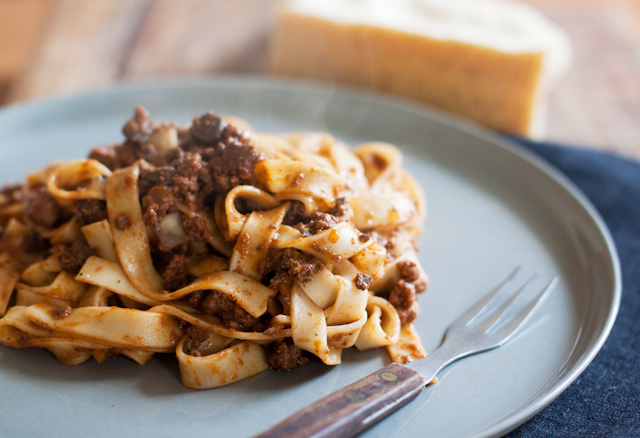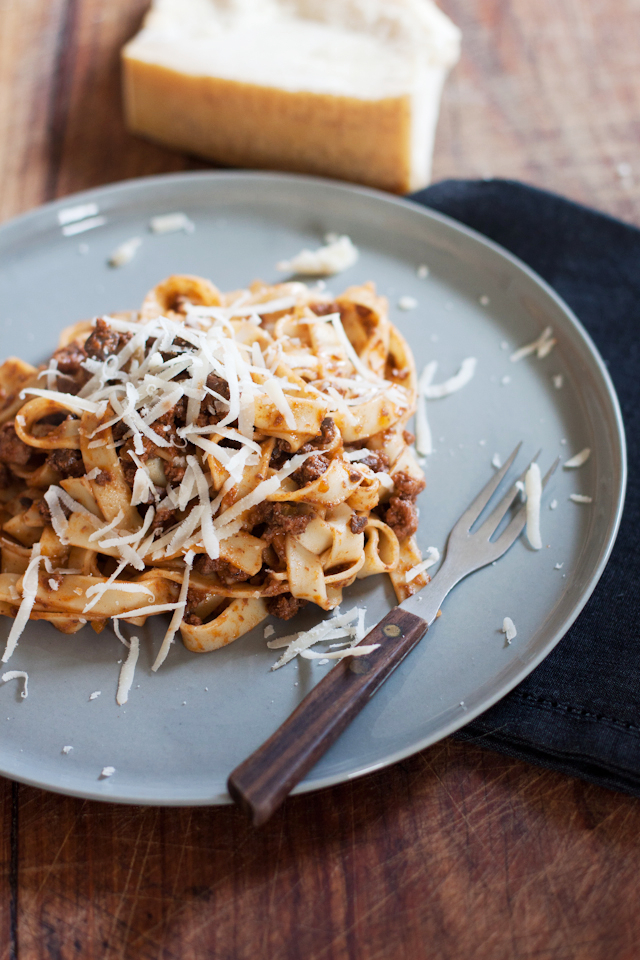Bologna is only 100 kilometres from Florence yet it is a food-world away. The home of mortadella, tortellini, lasagne, cappelletti and tagliatelle pasta – served of course with the most famous pasta sauce in the world, ragu alla bolognese – Bologna is in many ways the centre of Italian cuisine.

It helps that this food-centric city is in Emilia-Romagna, a region also blessed with other staples of good Italian food including the balsamic vinegar of Modena, Parma’s prosciutto and Parmigiano Reggiano cheese and that wonderful flatbread, piadina. And that’s only scratching the surface. This inspirational and touching video by Massimo Bottura, chef of Italy’s most revered restaurant, Osteria Francescana, tells the stories of some of the region’s most traditional dishes, rustic dishes that speak of the past. It’s an incredible array of regional foods to be surrounded by.
The other culinary claim to fame that Emilia-Romagna has over other Italian regions is that it is the home of Pellegrino Artusi, the author of the 1891 bible of Italian cuisine, Science in the Kitchen and the Art of Eating Well and, as you may know, one of my favourite cooking references.
In short, it’s a region whose cuisine deserves to be devoured, quite literally, in any way possible. So this is a start. Ragu bolognese. And not just any ragu bolognese but one that I think will beat any bolognese recipe. It the one described in Elizabeth David’s Italian Food, which is the recipe of Zia Nerina (zia means “Aunt”), a woman that David describes as “titanic of proportion but angelic of face and manner.” Zia Nerina ran and owned the famous Trattoria Nerina in Bologna in the 1950s.
This is the sauce that should be layered with lasagne verdi, fresh sheets of spinach-laced lasagne, and bechamel or tossed with that other Bolognese classic, egg tagliatelle (pronounced with a silent ‘g’, please!)– long, flat noodles enriched with egg yolk, usually fresh rather than dried but found both ways.

Note that tomato paste (concentrato di pomodoro in Italian) was used much more frequently in the 50s when this recipe was written down by Elizabeth David. Today you could use passata (tomato puree) or canned chopped tomatoes, in larger quantities of course. I find the tomato paste gives an extra depth of flavour, beautiful colour and a silky sort of texture to the sauce so I tend to use tablespoons rather than the teaspoons that Elizabeth David gives. The chicken livers are a must – they give the ragu an additional earthy flavour. It’s hearty, meaty, delicious – everything you want in a good ragu bolognese.
Some Bolognese cooks are known to add a cupful of milk or cream right at the end, before serving, to make a smoother, creamier ragu. The choice is yours.

Zia Nerina’s ragu bolognese
Adapted only very slightly from Elizabeth David’s Italian Food. Makes about 6 portions. If you’re not using all of it at once, note that this recipe freezes well. Just heat up the defrosted sauce in a pan over medium heat with a ladleful of the water that your pasta is boiling in and away you go!
- 220 gr lean minced beef
- 110 gr chicken livers
- 160 gr pancetta, chopped into small pieces
- 1 small carrot, finely chopped
- 1 stalk of celery, finely chopped
- 1 brown onion, finely chopped
- 3 tbs tomato paste
- 1 wineglassful of white wine
- 2 wineglassfuls of homemade beef stock or water (here is Artusi’s recipe for classic beef stock or brodo)
- a knob of butter
- salt and pepper, to taste
- fresh nutmeg
- Parmigiano Reggiano cheese
Brown the pancetta gently in a deep, wide saucepan in the butter. When a lovely golden colour, add the soffritto of chopped carrot, celery and onion and gently sauté over a low heat until the onion is transparent.
Add the minced beef, stirring and turning to brown evenly, then add the chicken livers, chopped into small pieces. Brown for 2 or 3 minutes before adding the tomato paste and the white wine.
Season to taste with salt, pepper, and “a good scraping of nutmeg”, then add the beef stock or water. Cover and let simmer on low for 30-40 minutes.
Serve this ragu with tagliatelle (calculate 80 gr per head), tossing the hot pasta with the sauce in heated dish to thoroughly coat the pasta – a little knob of butter for this process doesn’t hurt either! Serve immediately with a huge chunk of Parmigiano Reggiano, passed around the table with the grater.




Comments
Bologna is one of my absolute favourite places in Italy, thank you for this and the Massimo Bottura link!
You’re welcome – it’s a little treasure of a video isn’t it?
Emiko, a beautiful recipe and I love the ‘wineglassful’ of this and that. Just wonderful!
That was Elizabeth David’s wording, which I love too and borrowed!
A wonderful recipe! Pasta dishes like this one are so comforting and tasty.
Cheers,
Rosa
Even if I’m vegetarian I read through your post because I’m interested in food history and geogrraphy. I even watched the video that I liked so much. Don’t laugh but a vegetarian Bolognese has been in my head for a while. I want to create something amazing that a meat eater would like too! Hopefully one day, I will!
I’m so glad that a vegetarian is reading my post on a very meaty bolognese! You might like this recipe, then, Zita – it even looks very much like a “bolognese”, it’s super tasty and is even vegan! It’s known as “sugo finto”, or fake sauce: https://www.emikodavies.com/blog/sugo-finto-with-handmade-pici/
Emiko, this looks and sounds amazing.
Not a fan of liver (chicken or otherwise), should I try this anyway or sub in more beef? You’ll probably just say to try both so I wil…
loving the blog. keep ’em coming
Shiro
Come on, Shiro, try it with the chicken livers! You only need a couple, and if you’re not sure, use even less. It blends in really well with the beef and pancetta and adds a layer of flavour and ‘meatiness’ that you won’t get from the beef alone. Try it, it might even convert you!
A flavorful, meaty ragu is one of my favorite comfort foods. I just grabbed a big bag of chicken livers from the farmer’s market, and because they only sell them in bulk I usually make a big batch of paté and freeze it, but this time I’ll use some of them for the ragu.
Just discovered your site and feeling very pleased. Your ragu looks wonderful and planning to make it when I next have a chance but just one question: is 3 tablespoons of tomato paste enough ? I am used to using much more paste or a whole bottle of passata when I do something similar.
Thanks! So – there’s an explanation in the text above, but hopefully can clarify as there seems to be a bit of confusion between paste and passata! Tomato paste (known as “concentrato” in Italian) is thick and as the name suggests, very concentrated! It usually comes in a small jar and should only be used in spoonfuls (or squirts, as you can also buy it in a tube like toothpaste). Using more than 3 spoonfuls would be overpowering (David even suggests teaspoons)! Tomato ‘passata’ is simply tomato puree and usually comes in a tall bottle. If you’re going by Elizabeth David’s original recipe, use the paste, but otherwise you can use the puree with much more liberty or until you have the right consistency. Hope that helps!
Thank you for the quick reply. I have the feeling that I tend to use way too much tomato (I often use BOTH passata AND tomato paste, believe it or not !) when doing my own version of bolognese. This recipe is a bit of an eye-opener for me – the chicken liver element certainly is a new one. Can’t wait to try it.
Well if you like a strong tomato flavour there’s nothing wrong in that. The traditional ragus are much less tomato-y than probably what you’re used to though! Chicken liver gives it a rich, earthy flavour and a rustic look I think. Definitely worth trying!
Ragù is a staple in every famiglia emiliana and each has its own recipe, some use half pork meat/ half beef and some pancetta, others use chicken livers. As a sicilian married with an “emiliano” guy I’ve learnt that ragù is a very serious matter here near Bologna 😉 my mother-in-law always says that a real tasty ragù should simmer gently for at least 3 hours! Honestly I cook it only for 1 hour and I think the taste stays good too (shhhh but don’t say it to her! lol). I’ll try this recipe, looks delicious!
Grazie e ciao!! 🙂
Alessandra
P.s. I love Australia!
Before trying and tasting this recipe, I was in the pork/beef camp, but there is something wonderfully earthy about the addition of chicken liver in this. Like any really good, classic recipe, there’s a different version for each household!
Sorry for the sad news but I’ve discovered that someone is using our pics in his own blog as if they were of his own. You can recognize yours here: http://www.revistacocina.com/cocina-italiana-pasta-la-bolonesa/
🙁
Oh thanks so much for pointing this out!
Everyone loves what you guys are usually up too.
Such clever work and exposure! Keep up the fantastic works guys I’ve included you guys to my personal blogroll.
This was wonderful, thank you! I had no chicken livers and was using 400g of minced beef, so used 100g fat back bacon, with four anchovies to approximately replace the savouriness of the chicken livers. Really was so good!
Great! Thanks for the feedback.
Hello-just discovered your website and was greatly surprised by this recipe. The one I use has everything in this one with addition of veal and pork and no liver. Is yours a more authentic and historic Bolognese?
Yes, this is a historic recipe (and I’d say authentic too), as mentioned in the article above it comes from Elizabeth David’s Italian Food from 1954 and it is the recipe of “Zia Nerina” who ran a popular trattoria in Bologna in the 50s. The liver helps gives a wonderful, rich depth of flavour.
Also mine does use milk instead of broth.
Thans Emiko, the liver really does add an extra. Never would have thought of it myself, but this is a great recipe! Sandra
Ciao!
I have had Elizabth David’s “Italian Cooking” book for over 30 years. Of the many recipes I have used, this one is by far the most frequent. I think I must have made hundreds of Zia Nerina’s Ragus over the years. Though I tend to use minced pork & veal over topside beef..
I am going to Bologna next year. Do you know whether her Trattoria still exists? I would love to take a pilgrimage there :))
Hi, did you manage to go to Bologna and did you find the restaurant?
Where can I find Zia Nerina’s original recipe please?